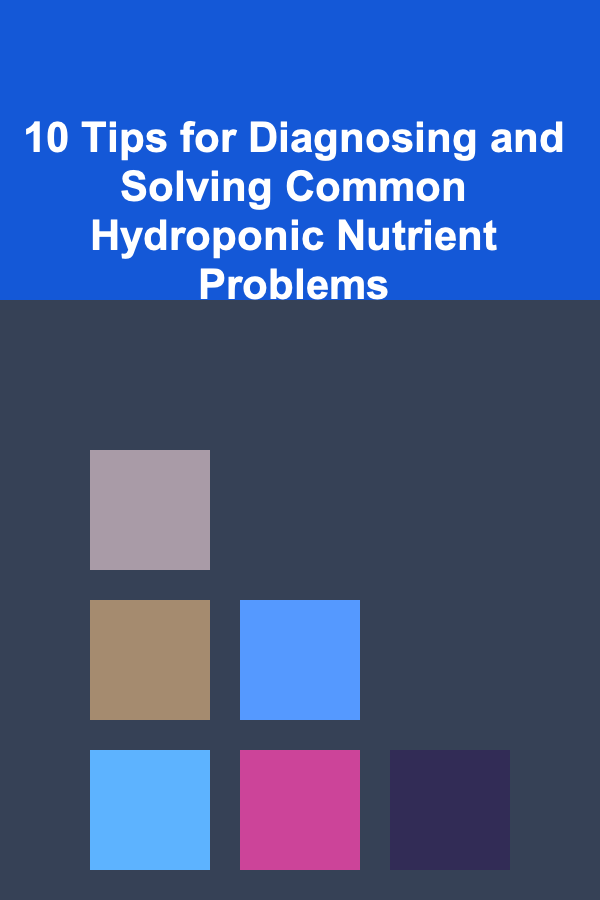
10 Tips for Diagnosing and Solving Common Hydroponic Nutrient Problems
ebook include PDF & Audio bundle (Micro Guide)
$12.99$9.99
Limited Time Offer! Order within the next:

Hydroponics, a method of growing plants without soil, has gained significant popularity due to its efficiency, reduced water usage, and the ability to grow crops in a controlled environment. However, achieving a successful hydroponic system involves understanding and maintaining the proper nutrient balance. Nutrient problems are common in hydroponic systems, and when they occur, they can quickly affect plant health and crop yield.
In this article, we will discuss 10 key tips for diagnosing and solving common hydroponic nutrient problems. By understanding these issues, you can ensure that your plants receive the appropriate nutrients, grow healthily, and achieve optimal results.
Understand the Essential Nutrients for Hydroponic Growth
The first step in diagnosing nutrient problems is to understand the essential nutrients plants require. Hydroponic systems depend on nutrient solutions to provide plants with the necessary elements for healthy growth. The primary nutrients are divided into macronutrients and micronutrients:
-
Macronutrients: These are the nutrients required in larger amounts.
- Nitrogen (N): Vital for leaf and vegetative growth.
- Phosphorus (P): Important for root development, flower formation, and energy transfer.
- Potassium (K): Helps in overall plant health, water regulation, and photosynthesis.
- Calcium (Ca): Strengthens cell walls and supports root growth.
- Magnesium (Mg): Central component of chlorophyll and necessary for photosynthesis.
- Sulfur (S): Helps in protein synthesis and enzyme function.
-
Micronutrients: These are required in smaller amounts but are equally crucial for plant health.
- Iron (Fe): Essential for chlorophyll production.
- Manganese (Mn): Involved in photosynthesis and nitrogen metabolism.
- Boron (B): Supports cell wall formation and reproductive processes.
- Copper (Cu): Important for photosynthesis and respiration.
- Zinc (Zn): Involved in enzyme function and protein synthesis.
- Molybdenum (Mo): Important for nitrogen metabolism.
Knowing the roles of these nutrients and the specific needs of the plants you're growing will help you diagnose problems quickly and accurately.
Monitor pH Levels Regularly
pH is one of the most crucial factors influencing nutrient availability in a hydroponic system. If the pH of the nutrient solution is too high or too low, plants may not be able to absorb the nutrients properly, even if they are present in the solution. The ideal pH range for most hydroponic plants is between 5.5 and 6.5.
- Symptoms of Incorrect pH :
- Too high (alkaline): Nutrient deficiencies, especially of micronutrients such as iron and manganese.
- Too low (acidic): Nutrient lockout, particularly of calcium, magnesium, and potassium.
Solution: Regularly test the pH of your nutrient solution using a reliable pH meter. Adjust the pH as needed by adding pH up (alkaline) or pH down (acidic) solutions.
Check Electrical Conductivity (EC) Levels
Electrical conductivity (EC) measures the concentration of dissolved salts (nutrients) in the nutrient solution. High or low EC levels can significantly impact plant health.
-
Symptoms of Low EC:
- Stunted growth and pale leaves, especially in newer growth.
- Weak root systems.
-
Symptoms of High EC:
- Leaf burn, particularly at the tips.
- Wilting despite the system being properly watered.
Solution : Regularly monitor the EC of your solution. For most plants, an EC range of 1.5 to 3.0 mS/cm is ideal, but it can vary depending on the plant species. Adjust nutrient concentration accordingly.
Identify and Correct Nutrient Deficiencies
One of the main issues in hydroponic systems is nutrient deficiencies. Plants show specific symptoms when they are lacking a particular nutrient. Here are some common deficiency signs:
- Nitrogen Deficiency: Yellowing of older leaves, stunted growth, and poor overall development.
- Phosphorus Deficiency: Purple or reddish leaves, particularly in older foliage.
- Potassium Deficiency: Yellowing at the leaf edges, browning or curling of leaf tips.
- Calcium Deficiency: Blossom end rot, leaf curling, or tip burn.
- Magnesium Deficiency: Interveinal chlorosis (yellowing between leaf veins), particularly on older leaves.
- Iron Deficiency: Yellowing between leaf veins with green veins remaining.
Solution: Adjust the nutrient solution based on the specific deficiencies. Use a well-balanced hydroponic nutrient solution designed for the plants you're growing. It may also be helpful to use foliar feeding for rapid correction of deficiencies.
Recognize the Effects of Excess Nutrients
While deficiencies are a major concern, too much of a nutrient can also cause problems. Excessive nutrients, especially nitrogen and phosphorus, can lead to several issues:
- Nutrient Burn: High concentrations of nutrients can cause burning on the leaf edges and tips.
- Overgrowth: Excessive nitrogen can cause plants to grow too quickly, leading to weak, spindly growth.
- Algae Growth: Overuse of phosphorus and potassium can encourage the growth of algae in your system, leading to poor oxygenation and a higher risk of disease.
Solution: Use nutrient solutions as per the manufacturer's instructions and always monitor the EC and pH. Flushing the system with fresh water occasionally can help reduce excess nutrient buildup.
Ensure Proper Oxygenation of the Nutrient Solution
Oxygen is essential for root health in hydroponic systems. Roots require oxygen to absorb nutrients effectively, and without sufficient oxygen, the roots may become oxygen-deprived, leading to nutrient deficiencies or poor plant growth.
- Symptoms of Poor Oxygenation :
- Yellowing leaves, particularly in the lower leaves.
- Stunted growth and weak roots.
- Root rot, which produces a foul smell.
Solution: Use air stones or air pumps to ensure that the nutrient solution is well-oxygenated. Regularly check the roots for signs of rot and consider using a higher-flow air pump or adding additional air stones if necessary.
Avoid Overcrowding in Your System
In a hydroponic system, overcrowding of plants can lead to competition for nutrients, light, and space. This can result in nutrient imbalances or deficiencies.
- Symptoms of Overcrowding :
- Plants are spindly and weak.
- Poor overall growth, with smaller-than-usual leaves or flowers.
- Lower yield due to competition for resources.
Solution: Space your plants appropriately to ensure that each plant has access to sufficient nutrients and light. Thinning out plants occasionally can also help prevent overcrowding.
Maintain the Temperature of the Nutrient Solution
Temperature plays an important role in nutrient absorption. If the temperature of the nutrient solution is too high or too low, plants may experience nutrient stress, which can lead to deficiencies or poor growth.
- Symptoms of Incorrect Temperature :
- Too high (above 75°F or 24°C): Roots may suffer from oxygen deprivation, and nutrient uptake can be reduced.
- Too low (below 60°F or 15°C): Nutrient uptake slows down, particularly for phosphorus, calcium, and potassium.
Solution : Maintain the nutrient solution temperature between 65°F and 75°F (18°C to 24°C). Use water chillers or heaters as necessary to regulate the temperature in your system.
Ensure Proper System Maintenance
Regular maintenance of your hydroponic system is essential for nutrient management. Accumulation of debris, algae, and nutrient salts can disrupt nutrient uptake and clog the system.
- Symptoms of System Clogging :
- Poor water flow and nutrient delivery.
- Plants showing signs of stress despite nutrient adjustments.
Solution: Clean the system regularly, especially the nutrient reservoir, pumps, and tubing. Periodically flush the system to prevent the buildup of salts and debris.
Test for Contaminants and Toxins
In hydroponic systems, contaminants such as heavy metals, chemicals from plastics, or pathogens can affect plant health and nutrient uptake. Contaminants can interfere with nutrient absorption, leading to symptoms that may mimic nutrient deficiencies.
- Symptoms of Contaminants :
- General plant decline with no clear cause.
- Chlorosis or browning of leaves despite correct nutrient levels.
- Unexplained poor growth or root damage.
Solution: Use high-quality, food-grade materials for your hydroponic system. Test the water for contaminants like heavy metals and pathogens, and consider using filtration or purification systems to improve water quality.
Conclusion
Hydroponic nutrient problems can be challenging, but with a solid understanding of how nutrients affect plant growth, regular monitoring of your system, and quick intervention, most issues can be resolved effectively. By applying these 10 tips, you'll be better equipped to diagnose and solve common nutrient problems, leading to healthier plants, better yields, and more successful hydroponic gardening.
Remember, consistency and attention to detail are key to mastering the art of hydroponic nutrient management. Regular testing, adjusting, and maintaining the system will ensure that your plants thrive in a balanced and nutrient-rich environment.
Reading More From Our Other Websites
- [Horseback Riding Tip 101] How to Care for and Maintain Your Horse Riding Boots for Longevity
- [Biking 101] How to Maintain and Care for Your Vintage Bikes
- [Home Security 101] How to Prevent Break-ins with Better Outdoor Security Practices
- [Home Rental Property 101] How to Handle Security Deposits and Avoid Legal Issues
- [Home Storage Solution 101] How to Build or Modify a Toy Chest to Maximize Storage and Functionality
- [Whitewater Rafting Tip 101] Top 10 Essential Safety Tips Every Rafting Enthusiast Should Know
- [Personal Investment 101] How to Invest in Royalties & Intellectual Property
- [Home Family Activity 101] How to Build a Family-Friendly Movie Night at Home
- [Rock Climbing Tip 101] Safety First: Mastering Trust and Rescue Techniques with Your Climbing Partner
- [Home Storage Solution 101] How to Organize Your Shoes with Creative Storage Ideas for Any Space

How to Edit Your YouTube Videos for Maximum Engagement
Read More
How to Use Drawer Organizers for Kitchen Utensils
Read More
How to Identify Straw Man Arguments in Conspiracy Debates
Read More
How to Fuel Your Workouts with Healthy Food
Read More
How to Track Hidden Investment Fees and Expenses
Read More
How to Batch Tasks on Your Blogging To-Do List for Maximum Efficiency
Read MoreOther Products

How to Edit Your YouTube Videos for Maximum Engagement
Read More
How to Use Drawer Organizers for Kitchen Utensils
Read More
How to Identify Straw Man Arguments in Conspiracy Debates
Read More
How to Fuel Your Workouts with Healthy Food
Read More
How to Track Hidden Investment Fees and Expenses
Read More